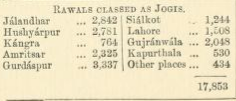The Jogi, Rawal and Nath
This article is an extract from PANJAB CASTES SIR DENZIL CHARLES JELF IBBETSON, K.C. S.I. Being a reprint of the chapter on Lahore: Printed by the Superintendent, Government Printing, Punjab, 1916. Indpaedia is an archive. It neither agrees nor disagrees |
The Jogi, Rawal and Nath
Caste Nos. 40 and 80 The figures under the head Jogi include two very distinct classes of persons. First are the Jogis proper, a regular religious order of Hindus, which includes both the Augar Jogis and the Kanphatta Jogi ascetics, who are followers of Gorakhnath and priests and worshippers of Siva. These men are fully as respectable as the Bairagis, Gosains, and other religious orders. So far as the sub-divisional tables help us, the present figures include 9,143 of this class, of whom 5,769 are males, but the real number is probably greater. They are all Hindus. They 228 have been discussed in the earlier portion of this section, at The second class is that miscellaneous assortment of low-caste faqirs and fortune tellers, both Hindu and Musalraan but chiefly Musalmau, who are commonly known as Jogis. The word Jogi or Yogi means a student of the Joga school of philosophy, which teachs how, by suppression of the breath, mental abstrac tion, and the like, to obtain supernatural powers of divination, second sight, and so forth ;' and the result is that every rascally beggar who pretends to be able to tell fortunes, or to practise astrological and necromantic arts in however small a degree, buys himself a druiu and calls himself and is called by others a Jogi. These men include all the Musalmans, and probably a part of the Hindus of the eastern districts who have been returned as Jogis.
They are a thoroughly vagabond set, and wander about the country beating a drum and begging, practising surgery and physic in a small way, writing charms, telling fortunes, and practising exorcism and divination ; or, setthng in the villages, eke out their earnings from these occupations by the offerings made at the local shrines of the malevolent godlings or of the Saiyads and other Musalraan saints (see sections 216 and 226) ; for the Jogi is so impure that he will eat the offerings made at any shrine. These people, or at least the Musalraan section of them, are called in the centre of the Paujab Rawals, or sometimes Jogi-Rawals, from the Arabic BaniMal a diviner, which again is derived from ramal sand with which the Ai-ab magicians divine ; and the two sets of figures must be taken together, always remembering that those for Jogis include respectable Jogis, while those for Rjiwals, who are all Musalmans, do not. The Jogi-Rawals of Kathiawar are said to be exorcisers of evil spirits, and to worship a deity called Korial. In Sialkot the Jogis pretend to avert storms from the ripening crops by plunging a d^awn sword into the field or a knife into a mound, sacrificing goats, and accepting suitable offerings. Mr. Benton writes: — The Jogi is a favourite character in Hindustani fiction. He there appears as a jolly playful character of a simple disposition, See Wilson's Sects of the Hindus, pages 130 for a very interesting account of both classes of Jogis, and for references to further authorities. who enjoys the fullest liberty and conducts himself in the most eccentric fashion under the cloak of religion without being called in question.
The Rawals of the Panjab are notorious cheats. One of their favourite devices is to personate a long lost relative. In the Province itself they seldom venture upon open crime ; but they travel about the Central Provinces and the Deccan and even visit Bombay and Calcutta and there pilfer and rob. They are often absent for long periods on these expeditions ; and meanwhile the Banyas of their villages support their families on credit, to be repaid with interest on the return of the father. Some interesting information regarding them will be found in Selected Papers, No. XMN of l869 of the Panjab Police Department. The town of Rawalpindi is named after the Rawals ; but the Rawals of the district appear to have returned themselves either as Jogis or more probably as Mughals, as 1,263 of the Mughals of Rawalpindi give Rawal as their clan. There they are said, in addition to their usual pursuits, to recite at the Muharram stories of the doings of Mahomet, accounts of his miracles, and hymns in his praise.
The Naths of the higher hills, where the worship of Siva is prevalent, correspond very closely with the Jogis of the plains, though they make little pretence to an ascetic character and live chiefly by growing vegetables ; but they also perform certain semi-sacerdotal function, taking the place of the Acharj of the plains in the funeral ceremonies of the Kanets, and receiving like him the clothes of the deceased. They also consecrate new houses, and purify them when they have been defiled. They now form a true caste, and are not recruited from without. One or more in almost every Natb household has his ears pierced in honour of Siva, and is called a Kanphatta Nath. They occupy much the same social position as the Jogi-Rawal of the plains. They are understood to have returned themselves as Jogis and to be included in the figures now under discussion.
Of the figures given in Table VIII A, all the Hindus are men returned as Jogis. Of the JNIusalmans the numbers shown in the margin were returned as Rawals, the remain der being: Jogis.
See The Bahrupia
